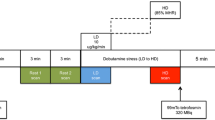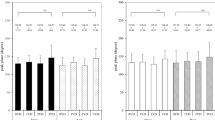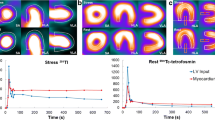Abstract
Purpose
The purpose of the present study was to evaluate the feasibility of gated blood pool single-photon emission computed tomography (GBPS) with low-dose dobutamine (LDD) stress test, performed on a single-photon emission computed tomography (SPECT) camera equipped with cadmium-zinc-telluride (CZT) solid-state detectors, in assessing of left ventricle (LV) contractile reserve in patients with ischemic cardiomyopathy (ICM).
Methods
A total of 52 patients (age 59 ± 7.2 years, 47 men and 5 women) with ICM and a control group of 10 patients without obstructive coronary artery lesion underwent GBPS and transthoracic echocardiography (TTE) at rest and during LDD stress test (5, 10, 15 µg/kg/min). The duration of each GBPS step was 5 min. Stress-induced changes in LV ejection fraction (ΔLVEF), peak ejection rate, LV volumes, and mechanical dyssynchrony (phase histogram standard deviation, phase histogram bandwidth and entropy) obtained with GBPS were estimated.
Results
All GBPS indices except end-diastolic volume showed significant dynamics during stress test in both groups. The majority of parameters in ICM patients showed significant changes at a dobutamine dose of 10 µg/kg/min as compared to the rest study. Seventeen percent of ICM patients, but none from the control group, showed a decrease in LVEF during stress, accompanied by a significant increase in entropy. The intra- and inter-observer reproducibility was excellent for both rest and stress studies. There was a moderate correlation (r = 0.5, p = 0.01) between GBPS and TTE, with a mean difference value of − 1.7 (95% confidence interval − 9.8; 6.4; p = 0.06) in ΔLVEF.
Conclusion
Low-dose dobutamine stress GBPS performed with high-efficiency CZT-SPECT cameras can be performed for evaluating stress-induced changes in LV contractility and dyssynchrony with lower acquisition time. A dobutamine dose of 10 µg/kg/min can potentially suffice to detect stress-induced changes in patients with ICM during GBPS.
Trial registration
ClinicalTrials.gov identifier: NCT04508608 (August 7, 2020).







Similar content being viewed by others
Data availability
Not applicable.
References
Corbett JR, Akinboboye OO, Bacharach SL, et al. Equilibrium radionuclide angiocardiography. J Nucl Cardiol. 2006;13(6):e56–79. https://doi.org/10.1016/j.nuclcard.2006.08.007.
Zafrir N, Vidne B, Sulkes J, Sclarovsky S. Usefulness of dobutamine radionuclide ventriculography for prediction of left ventricular function improvement after coronary artery bypass grafting for ischemic cardiomyopathy. Am J Cardiol. 1999;83(5):691–5. https://doi.org/10.1016/s0002-9149(98)00972-2.
Verna E, Ghiringhelli S, Scotti S, Caravati F. Evaluation of baseline contractile reserve vs dyssynchrony as a predictor of functional improvement and long term outcome after resynchronization pacing therapy: a radionuclide stress study. J Nucl Cardiol. 2012;19(1):53–62. https://doi.org/10.1007/s12350-011-9421-9.
Kasama S, Toyama T, Hoshizaki H, et al. Dobutamine gated blood pool scintigraphy predicts the improvement of cardiac sympathetic nerve activity, cardiac function, and symptoms after treatment in patients with dilated cardiomyopathy. Chest. 2002;122(2):542–8. https://doi.org/10.1378/chest.122.2.542.
Salimian S, Thibault B, Finnerty V, Grégoire J, Harel F. Phase analysis of gated blood pool SPECT for multiple stress testing assessments of ventricular mechanical dyssynchrony in a tachycardia-induced dilated cardiomyopathy canine model. J Nucl Cardiol. 2017;24(1):145–57. https://doi.org/10.1007/s12350-015-0338-6.
Chen YC, Ko CL, Yen RF, et al. Comparison of biventricular ejection fractions using cadmium-zinc-telluride SPECT and planar equilibrium radionuclide angiography. J Nucl Cardiol. 2016;23(3):348–61. https://doi.org/10.1007/s12350-015-0367-1.
Duvall WL, Guma-Demers KA, George T, Henzlova MJ. Radiation reduction and faster acquisition times with SPECT gated blood pool scans using a high-efficiency cardiac SPECT camera. J Nucl Cardiol. 2016;23(5):1128–38. https://doi.org/10.1007/s12350-015-0214-4.
van Dijk JD. Dose-optimization in nuclear cardiac imaging, time for the next step? J Nucl Cardiol. 2019;26(6):1981–3. https://doi.org/10.1007/s12350-018-1441-2.
Acampa W, Zampella E, Assante R, et al. Quantification of myocardial perfusion reserve by CZT-SPECT a head to head comparison with 82Rubidium PET imaging. J Nucl Cardiol. 2020;28:2827–39. https://doi.org/10.1007/s12350-020-02129-w.
Acampa W, Assante R, Mannarino T, et al. Low-dose dynamic myocardial perfusion imaging by CZT-SPECT in the identification of obstructive coronary artery disease. Eur J Nucl Med Mol Imaging. 2020;47(7):1705–12.
Mannarino T, Assante R, Ricciardi C, et al. Head-to-head comparison of diagnostic accuracy of stress-only myocardial perfusion imaging with conventional and cadmium-zinc telluride single-photon emission computed tomography in women with suspected coronary artery disease. J Nucl Cardiol. 2021;28(3):888–97.
Cantoni V, Green R, Acampa W, et al. Diagnostic performance of myocardial perfusion imaging with conventional and CZT single-photon emission computed tomography in detecting coronary artery disease: a meta-analysis. J Nucl Cardiol. 2021;28(2):698–715.
Zavadovsky KV, Mochula AV, Boshchenko AA, et al. Absolute myocardial blood flows derived by dynamic CZT scan vs invasive fractional flow reserve: correlation and accuracy. J Nucl Cardiol. 2021;28(1):249–59.
Felker GM, Shaw LK, O’Connor CM. A standardized definition of ischemic cardiomyopathy for use in clinical research. J Am Coll Cardiol. 2002;39(2):210–8. https://doi.org/10.1016/s0735-1097(01)01738-7.
Henzlova MJ, Duvall WL, Einstein AJ, Travin MI, Verberne HJ. ASNC imaging guidelines for SPECT nuclear cardiology procedures: stress, protocols, and tracers [published correction appears in J Nucl Cardiol. 2016 Jun;23(3):640-2]. J Nucl Cardiol. 2016;23(3):606–39. https://doi.org/10.1007/s12350-015-0387-x.
Lang RM, Badano LP, Mor-Avi V, et al. Recommendations for cardiac chamber quantification by echocardiography in adults: an update from the American Society of Echocardiography and the European Association of Cardiovascular Imaging. J Am Soc Echocardiogr. 2015;28(1):1-39.e14. https://doi.org/10.1016/j.echo.2014.10.003.
Nakajima K, Okuda K, Matsuo S, Slomka P. Making the invisible visible: phase dyssynchrony has potential as a new prognostic marker. J Nucl Cardiol. 2019;26:298–302.
Mattsson S, Johansson L, Leide Svegborn S, et al. Radiation dose to patients from radiopharmaceuticals: a compendium of current information related to frequently used substances [published correction appears in Ann ICRP. 2019 Sep;48(1):96]. Ann ICRP. 2015;44(2 Suppl):7–321. https://doi.org/10.1177/0146645314558019.
Groch MW, DePuey EG, Belzberg AC, et al. Planar imaging versus gated blood-pool SPECT for the assessment of ventricular performance: a multicenter study. J Nucl Med. 2001;42(12):1773–9.
Hansen NL, Haarmark C, Zerahn B. Ventricular peak emptying and filling rates measured by gated tomographic radionuclide angiography using a cadmium-zinc-telluride SPECT camera in chemotherapy-naïve cancer patients. J Nucl Cardiol. 2020;27(4):1193–201. https://doi.org/10.1007/s12350-019-01756-2.
Wells RG, Marvin B, Kovalski G, Ruddy TD. Planar radionuclide angiography with a dedicated cardiac SPECT camera. J Nucl Cardiol. 2013;20(3):358–66. https://doi.org/10.1007/s12350-013-9674-6.
Adachi I, Akagi H, Umeda T, et al. Gated blood pool SPECT improves reproducibility of right and left ventricular Fourier phase analysis in radionuclide angiography. Ann Nucl Med. 2003;17(8):711–6. https://doi.org/10.1007/BF02984981.
Romero-Farina G, Aguadé-Bruix S. Equilibrium radionuclide angiography: present and future. J Nucl Cardiol. 2021;28(4):1315–22. https://doi.org/10.1007/s12350-019-01876-9 (Epub 2019 Sep 3 PMID: 31482533).
Boogers MJ, Chen J, Veltman CE, et al. Left ventricular diastolic dyssynchrony assessed with phase analysis of gated myocardial perfusion SPECT: a comparison with tissue Doppler imaging. Eur J Nucl Med Mol Imaging. 2011;38(11):2031–9. https://doi.org/10.1007/s00259-011-1870-5.
AlJaroudi W, Jaber WA, Cerqueira MD. Effect of tracer dose on left ventricular mechanical dyssynchrony indices by phase analysis of gated single photon emission computed tomography myocardial perfusion imaging. J Nucl Cardiol. 2012;19(1):63–72. https://doi.org/10.1007/s12350-011-9463-z.
Chua T, Yin LC, Thiang TH, Choo TB, ** DZ, Leng LY. Accuracy of the automated assessment of left ventricular function with gated perfusion SPECT in the presence of perfusion defects and left ventricular dysfunction: correlation with equilibrium radionuclide ventriculography and echocardiography. J Nucl Cardiol. 2000;7(4):301–11. https://doi.org/10.1067/mnc.2000.105279.
Jensen MM, Schmidt U, Huang C, Zerahn B. Gated tomographic radionuclide angiography using cadmium-zinc-telluride detector gamma camera; comparison to traditional gamma cameras. J Nucl Cardiol. 2014;21(2):384–96. https://doi.org/10.1007/s12350-013-9844-6.
Chen Y, Xue X, Gu Y, Xu H, Zhang X. Equilibrium radionuclide angiography compared with tissue Doppler imaging for detection of right ventricular dyssynchrony and prediction of acute response to cardiac resynchronization therapy. Medicine (Baltimore). 2020;99(9): e19296. https://doi.org/10.1097/MD.0000000000019296.
Zavadovsky KV, Krivonogov NG, Lishmanov YB. The usefulness of gated blood pool scintigraphy for right ventricular function evaluation in pulmonary embolism patients. Ann Nucl Med. 2014;28(7):632–7. https://doi.org/10.1007/s12149-014-0861-6.
Soufer A, Liu C, Henry ML, Baldassarre LA. Nuclear cardiology in the context of multimodality imaging to detect cardiac toxicity from cancer therapeutics: established and emerging methods. J Nucl Cardiol. 2020;27(4):1210–24. https://doi.org/10.1007/s12350-019-01671-6.
De Bondt P, Claessens T, Rys B, et al. Accuracy of 4 different algorithms for the analysis of tomographic radionuclide ventriculography using a physical, dynamic 4-chamber cardiac phantom. J Nucl Med. 2005;46(1):165–71.
Pelletier-Galarneau M, Finnerty V, Tan S, Authier S, Gregoire J, Harel F. Assessment of left ventricular ejection fraction with cardiofocal collimators: comparison between IQ-SPECT, planar equilibrium radionuclide angiography, and cardiac magnetic resonance. J Nucl Cardiol. 2019;26(6):1857–64. https://doi.org/10.1007/s12350-018-1251-6.
Papageorgiou N, Providência R, Lambiase PD, Tousoulis D, Lloyd G, Bhattacharyya S. Does presence of left ventricular contractile reserve improve response to cardiac resynchronization therapy? An updated meta-analysis. Int J Cardiol. 2018;252:224–8. https://doi.org/10.1016/j.ijcard.2017.09.034.
Abdul Ghaffar Y, Maskoun W, Mustafa NG, Feigenbaum H, Sawada SG. Low dose wall motion score predicts the short and long-term benefit of surgical revascularization in patients with ischemic left ventricular dysfunction. Int J Cardiovasc Imaging. 2019;35(9):1651–9. https://doi.org/10.1007/s10554-019-01614-9.
Khemka A, Sawada SG. Dobutamine echocardiography for assessment of viability in the current era. Curr Opin Cardiol. 2019;34(5):484–9. https://doi.org/10.1097/HCO.0000000000000658.
Raja S, Mittal BR, Santhosh S, Bhattacharya A, Rohit MK. Comparison of LVEF assessed by 2D echocardiography, gated blood pool SPECT, 99mTc tetrofosmin gated SPECT, and 18F-FDG gated PET with ERNV in patients with CAD and severe LV dysfunction. Nucl Med Commun. 2014;35(11):1156–61. https://doi.org/10.1097/MNM.0000000000000182 (PMID: 25144559).
Kano N, Okumura T, Isobe S, et al. Left ventricular phase entropy: novel prognostic predictor in patients with dilated cardiomyopathy and narrow QRS. J Nucl Cardiol. 2018;25(5):1677–87. https://doi.org/10.1007/s12350-017-0807-1.
AlJaroudi W, Alraies MC, Hachamovitch R, et al. Association of left ventricular mechanical dyssynchrony with survival benefit from revascularization: a study of gated positron emission tomography in patients with ischemic LV dysfunction and narrow QRS. Eur J Nucl Med Mol Imaging. 2012;39(10):1581–91. https://doi.org/10.1007/s00259-012-2171-3.
Uebleis C, Hellweger S, Laubender RP, et al. Left ventricular dyssynchrony assessed by gated SPECT phase analysis is an independent predictor of death in patients with advanced coronary artery disease and reduced left ventricular function not undergoing cardiac resynchronization therapy. Eur J Nucl Med Mol Imaging. 2012;39(10):1561–9. https://doi.org/10.1007/s00259-012-2157-1.
Zhihao L, **gyu N, Lan L, et al. SERCA2a: a key protein in the Ca2+ cycle of the heart failure. Heart Fail Rev. 2020;25(3):523–35. https://doi.org/10.1007/s10741-019-09873-3.
Lee AP, Song JK, Yip GW, et al. Importance of dynamic dyssynchrony in the occurrence of hypertensive heart failure with normal ejection fraction. Eur Heart J. 2010;31(21):2642–9. https://doi.org/10.1093/eurheartj/ehq248.
Stankovic I, Aarones M, Smith HJ, et al. Dynamic relationship of left-ventricular dyssynchrony and contractile reserve in patients undergoing cardiac resynchronization therapy. Eur Heart J. 2014;35(1):48–55. https://doi.org/10.1093/eurheartj/eht294.
Lafitte S, Bordachar P, Lafitte M, et al. Dynamic ventricular dyssynchrony: an exercise-echocardiography study. J Am Coll Cardiol. 2006;47(11):2253–9. https://doi.org/10.1016/j.jacc.2005.11.087.
Kurita T, Onishi K, Dohi K, et al. Impact of heart rate on mechanical dyssynchrony and left ventricular contractility in patients with heart failure and normal QRS duration. Eur J Heart Fail. 2007;9(6–7):637–43. https://doi.org/10.1016/j.ejheart.2007.03.002.
Yagishita-Tagawa Y, Abe Y, Arai K, et al. Low-dose dobutamine induces left ventricular mechanical dyssynchrony in patients with dilated cardiomyopathy and a narrow QRS: a study using real-time three-dimensional echocardiography. J Cardiol. 2013;61(4):275–80. https://doi.org/10.1016/j.jjcc.2012.12.012.
Chattopadhyay S, Alamgir MF, Nikitin NP, Fraser AG, Clark AL, Cleland JG. The effect of pharmacological stress on intraventricular dyssynchrony in left ventricular systolic dysfunction. Eur J Heart Fail. 2008;10(4):412–20. https://doi.org/10.1016/j.ejheart.2008.02.004.
Salimian S, Thibault B, Finnerty V, Grégoire J, Harel F. The effects of dobutamine stress on cardiac mechanical synchrony determined by phase analysis of gated SPECT myocardial perfusion imaging in a canine model. J Nucl Cardiol. 2014;21(2):375–83. https://doi.org/10.1007/s12350-013-9847-3.
Legallois D, Marie PY, Franken PR, Djaballah W, Agostini D, Manrique A. Comparison of the dyssynchrony parameters recorded with gated SPECT in ischemic cardiomyopathy according to their repeatability at rest and to their ability to detect a synchrony reserve under dobutamine infusion. J Nucl Cardiol. 2020;27(6):2247–57. https://doi.org/10.1007/s12350-018-01546-2.
Singh H, Patel CD, Sharma P, Naik N, Singh S, Narang R. Does perfusion pattern influence stress-induced changes in left ventricular mechanical dyssynchrony on thallium-201-gated SPECT myocardial perfusion imaging? J Nucl Cardiol. 2015;22(1):36–43. https://doi.org/10.1007/s12350-014-9979-0.
Ferro A, Petretta M, Acampa W, et al. Post-stress left ventricular ejection fraction drop in patients with diabetes: a gated myocardial perfusion imaging study. BMC Cardiovasc Disord. 2013;13:99. https://doi.org/10.1186/1471-2261-13-99 (Published 2013 Nov 14).
Go V, Bhatt MR, Hendel RC. The diagnostic and prognostic value of ECG-gated SPECT myocardial perfusion imaging. J Nucl Med. 2004;45(5):912–21.
Miller RJH, Hu LH, Gransar H, et al. Transient ischaemic dilation and post-stress wall motion abnormality increase risk in patients with less than moderate ischaemia: analysis of the REFINE SPECT registry. Eur Heart J Cardiovasc Imaging. 2020;21(5):567–75. https://doi.org/10.1093/ehjci/jez172.
AlJaroudi WA, Hage FG. Myocardial stunning by gated SPECT: an old tool reinvented in a stunning turn. J Nucl Cardiol. 2019;26(3):841–4. https://doi.org/10.1007/s12350-017-1127-1.
Ben-Haim S, Gips S, Merdler A, Front A, Tamir A. Myocardial stunning demonstrated with rest and post-stress measurements of left ventricular function using dual-isotope gated myocardial perfusion SPECT. Nucl Med Commun. 2004;25(7):657–63. https://doi.org/10.1097/01.mnm.0000126510.81093.02.
Jiang Z, Tang H, Shi J, Zhou Y, Wang C, Li D, Shan Q, Zhou W. Myocardial stunning-induced left ventricular dyssynchrony on gated single-photon emission computed tomography myocardial perfusion imaging. Nucl Med Commun. 2018;39(8):725–31. https://doi.org/10.1097/MNM.0000000000000870 (PMID: 29794947).
Cortés CM, Aramayo GEN, Barboza PE, Crottogini A, Embon MA. Impact of early post-stress 99mTc sestamibi ECG-gated SPECT myocardial perfusion imaging on the detection of ischemic LV dyssynchrony: an early step in the stunning cascade. Int J Cardiovasc Imaging. 2021;37(5):1789–98. https://doi.org/10.1007/s10554-020-02145-4.
Mut F, Giubbini R, Vitola J, Lusa L, Sobic-Saranovic D, Peix A, et al. Detection of post-exercise stunning by early gated SPECT myocardial perfusion imaging: results from the IAEA multi-center study. J Nucl Cardiol. 2014;21:1168–76.
Brodov Y, Fish M, Rubeaux M, Otaki Y, Gransar H, Lemley M, et al. Quantitation of left ventricular ejection fraction reserve from early gated regadenoson stress Tc-99m high-efficiency SPECT. J Nucl Cardiol. 2016;23:1251–61.
Shimizu M, Iiya M, Fujii H, Kimura S, Suzuki M, Nishizaki M. Left ventricular end-systolic contractile entropy can predict cardiac prognosis in patients with complete left bundle branch block. J Nucl Cardiol. 2019;28:162–71.
Kita A, Onoguchi M, Shibutani T, Sugimoto K, Kosaka N, AdachiT, et al. Influence of myocardial count on phase dyssynchrony analysis of gated myocardial perfusion single-photon emission computed tomography. Nucl Med Commun. 2019;40:124–30.
Acknowledgements
We thank Dr. Tamara R. Ryabova, PhD, and Dr. Vadim A. Katkov who performed TTE examinations. We thank Dr. Ora Israel for her comments and suggestions.
Author information
Authors and Affiliations
Corresponding author
Ethics declarations
Ethics approval
All procedures performed in this study were in accordance with the ethical standards of the institutional and/or national research committee and with the 1964 Helsinki declaration and its later amendments or comparable ethical standards.
Consent to participate
Written and oral informed consent was provided by the patient involved in this study.
Conflict of interest
The authors declare no competing interests.
Additional information
Publisher's Note
Springer Nature remains neutral with regard to jurisdictional claims in published maps and institutional affiliations.
This article is part of the Topical Collection on Cardiology
Supplementary Information
Below is the link to the electronic supplementary material.
Rights and permissions
About this article
Cite this article
Shipulin, V., Andreev, S., Pryakhin, A. et al. Low-dose dobutamine stress gated blood pool SPECT assessment of left ventricular contractile reserve in ischemic cardiomyopathy: a feasibility study. Eur J Nucl Med Mol Imaging 49, 2219–2231 (2022). https://doi.org/10.1007/s00259-022-05714-y
Received:
Accepted:
Published:
Issue Date:
DOI: https://doi.org/10.1007/s00259-022-05714-y




